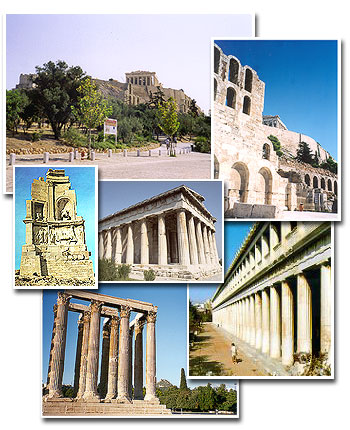
The ancient quarters
Here, time seems to have stopped 200 years ago, when under the oppressive and age-long domain of the Ottomans, Athens had become a small village on the hillside of the Acropolis. Nowadays these quarters are still made of narrow streets, small houses, minute Byzantine churches and a large number of ancient archaeological sites. As this is the oldest inhabited area of the city, it has been identified as part of its historical heritage. It is nearly all closed to traffic and has been restored and pedestrianised. Currently, the quarters making up this area are Plaka, Monastiraki, Anafiotika, Psir� and Thissio where you can get the feel of the Byzantine and Ottoman periods and the neoclassical period of the 1800. These areas have been built on the ancient foundations and the streets you walk along are the same once used by inhabitants such as Pericles, Sophocles and Plato. The area is one of the oldest residential and commercial areas in Europe and this adds to its charm.PLAKA
It's the oldest quarter of the city. It was one of the first areas in Athens to be inhabited and the first settlement is thought to have been nearly 7000 years ago.
It is mostly pedestrianized, renovated and isolated from both the traffic and noise of the city, which makes it a real oasis in which to discover ancient Athens. It is made up of narrow and winding streets full of vegetation, small neoclassical houses and minute Byzantine churches of the 10th - 12th Century A. D. Here hundreds of years of history are revealed to us, in an atmosphere that takes us back to its splendid origins. In fact, many of its streets are built on the traces of the ancient Athenian streets; while walking along the alleyways you can run into wonderful archaeological sites such as the monument to Lysicrates or the roman agora. It is the ideal place to relive the life of ancient inhabitants.
Plaka has always been the residential area of the city, it is nowadays one of the few areas of Athens along with Monastiraki to have preserved evidence of its past prior to the 20th century. While other historical areas have been flattened to dig for the foundations of the old city (like the sites of the agor� and the keramikes), here archaeologists haven't managed to dig because the area has always been inhabited. This has enabled us to re-live the Athens of 100, 200, 500 and 1000 years ago, in a place that has been inhabited for nearly 7000 years.
Plaka nowadays has quite a few open-air caf�s, charming little restaurants and small theatres, showing that in the last century, the area has gone from being residential to being touristy. However, thanks to recent government provisions, it is also being transformed once again into a residential area.
MONASTIRAKI
During the 400 years of Ottoman domination, Monastiraki was the commercial centre of Athens. In ancient times the area must have been an important commercial centre. Nowadays it has kept its oriental flavour; in fact many people call it the Turkish quarter. It is definitely a very lively and folkloristic area, just like a bazaar.
Every Sunday the famous flea market takes place, making Monastiraki ideal for people who love a busy and lively environment. It is crowded with stalls, small shops selling souvenirs, leather goods and antiques.
Besides its commercial and folkloristic aspect, the area is full of historical remains, in fact it not only has an oriental feel which is the legacy of the Ottoman occupation, but it is also situated between the agora and Hadrian's library. The ancient Hellenic splendour combined with the Ottoman heritage is of great impact. There is a magnificent Byzantine church of 10th century, a former monastery, from which the whole area gets its name, two former Turkish mosques currently housing museums and one of the oldest metro stations in Athens which dates from 1862. The area must have been the focal point for commerce also in the past, because of its position between the two agor�s.
PSIRI
Psiri is the old artisan quarter. Since ancient times this area has been the home of all craftsmen,
the potters, the sculptors and so on.

However, throughout the centuries it has greatly suffered and has lost much of its architectural heritage. It is however possible to see three of the many Byzantine churches that used to crowd the area till the 1800s and that were subsequently demolished to make place for the many archaeological excavations of the time. Among the modern buildings there are some interesting and diverse examples of architecture of the last centuries.
The area has only been rediscovered of late. It was neglected for most of the 20th century, and only in the past years has been redeveloped by reconverting and revitalising its historical areas. Today Psiri is bustling with artisans' workshops, bars, restaurants and many nightclubs. In recent years the number of growing commercial and cultural activities have been slowly turning the area into "the Soho" of Athens.
ANAFIOTIKA
This quarter is huddled on the slopes of the Acropolis, south of Plaka. It gets its name from the houses built in cycladic style by the inhabitants of the Isle of Anafi, who moved here at the beginning of the 1800s, following years of oppressive Ottoman domain.
If you wander through the streets of this small village, you get the feeling of being on one of the islands of the Cyclades, with its tiny houses, ornamental plants, narrow alleyways and the typical white-washed steps and buildings.
THISIO
The quarter is next to Keramikos and of the temple of Thisio, from which it gets its name. This area has also been inhabited since ancient times despite the little evidence of the past. Nowadays it is renowned for its numerous fashionable caf�s.